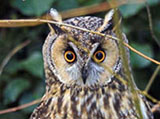
MENDIP LONG-EARED OWL SPECIES ACTION PLAN
Action plan name
Mendip Long-eared owl (Asio otus)
Background and vision
To reduce and reverse the decline of this scarce species of owl, using a grass roots approach to creative conservation, education and awareness raising.
Whole communities, where appropriate, will be invited and encouraged to help with surveys, monitoring and habitat restoration, to create a more sustainable population of Long-eared Owls in the Mendip District.
Plan species and habitats
· Heathlands
· Woodland (deciduous and planted conifer)
· Species-rich grassland
Associated species and habitats
Other species that will benefit from any measures produced to help Longeared Owl include:
· The Brown Hare
· Adder
· Grassnake
· Nightjar
· Song Thrush
· Water Vole
· Tree Pipit
· Barn Owl
Species status
UK Priority Habitats: Species-rich grassland, woodland and Lowland heathland.
The estimated population of Long-eared owl is 2,000 to 2,500 pairs in UK.
Due to a lack of information there is currently no mention of this species within the Birds of Conservation Concern List, although it is mentioned within the International Berns Convention list of endangered species.
Long-eared Owl is important for UK BAP species, as Owls generate a lot of public sympathy and this alone will help to raise the public profile of all current BAP plans. As information on this species is as scarce as the species itself, this SAP will not only benefit future and current conservation plans for Long-eared Owl, but will also deliver and raise awareness of a lot more besides.
Specific impacts/threats
Current threats to Long-eared Owl in the Mendip District include:
· Loss of prey-rich grassland
· Afforestation of Heathland and other semi-natural habitats has been a threat in the past but now most new planting occurs on intensively managed agricultural land which becomes good hunting ground for a few years
· Nesting site disturbance
· Lack of numbers - making a fragmented, non-viable population
· Change to agriculture policy
· Extreme weather events
Proposed partners
Forestry Commission (FC)
West Somerset District Council (WSDC)
Confirmed partners
Mendip District Council (MDC)
Somerset County Council (SCC)
Hawk and Owl Trust (H&OT)
Somerset Wildlife Trust (SWT)
Quantock Area of Natural Beauty (QAONB)
Mendip Area of Natural Beauty (MAONB)
Avon and Somerset Constabulary (A&SC)
Somerset Environmental Records Centre (SERC)
Farming and Wildlife Advisory Group (FWAG)
Somerset Ornithological Society (SOS)
Current action
· Annual Feb/March pre-breeding adult (calling) surveys
· Owlet productivity surveys (summer)
· Advisory visits to landowners
· Awareness-raising through publicity, etc
Target description and target goals
1. To re-assess all existing data for the Long-eared Owl and associated BAP species and supply new data
Goal: Updated data to SERC by 2009.
2. Maintain and look to increase population of the Long-eared Owl in the Mendip District.
Goal: % Population maintained.
3. Raise the profile of the Long-eared Owl through events and publicity.
Goal: At least 4 events or publications.
4. Increase the available information on the Long-eared Owl.
Goal: 100% existing literature updated and new one produced.
Key factors
· Successful funding applications.
· Awareness and cooperation of all partners is essential.
· Awareness and cooperation of the general public.
· Any work to clear coniferous plantations from previousl Heathland areas (see Heathland Habitat Action Plan) should take into account the habitat requirements of the Long-eared Owl.



